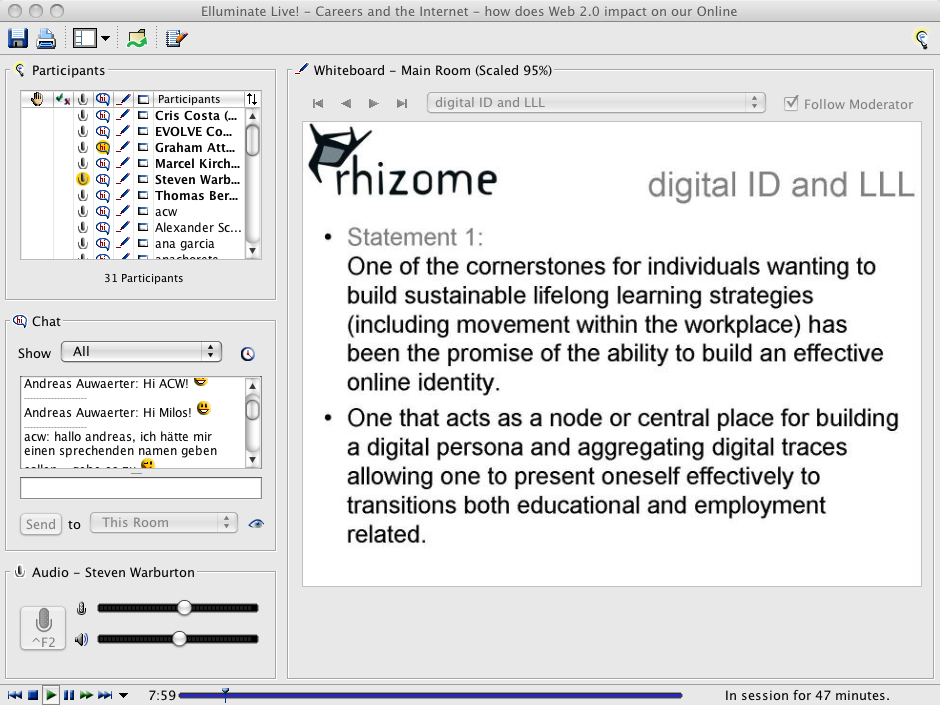I am speaking at a joint Evolve / Educamp on line session tonight about e-Portfolios and PLes. Coincidentally, I have been working on background research for the Mature project which is seeking to develop Personal Learning and Management Environments to support professional development and knowledge maturing services.
One topic in my brief for Mature was to look at barriers to the introduction of PLEs and PLMEs. As I wrote two weeks ago, PLEs are with us now – in the sense of how learners are using computers to support their own learning. But at the same time there appear to remain institutional and organisational barriers to the wider adoption of PLEs.
Anyway this is what I came up with for the Mature work. I would love any comments or feedback.
Issues in introducing PLEs
Despite the interest from the educational technology community, the implementation and institutional support for PLEs remains slow. This may be a reflection of the need to address a series of issues, both related to approaches to teaching and learning and technology development.
Learner Confidence and Support
One of the reasons why current VLEs have been successful is that they allow universities to centralize support and thus ensure a certain level of competence and quality of experience (Weller, 2005). Supporting learners in creating their own learning environments would be a major challenge.
Furthermore many learners may not have the confidence and competence to develop and configure their own tools for learning. However, Wild, Mödritscher and Sigurdarson, (2008) consider that “by establishing a learning environment, i.e. a network of people, artefacts, and tools (consciously or unconsciously) involved in learning activities, is part of the learning outcomes, not an instructional condition.”
Moreover, the advances in Wb 2.0 tools and social software are reducing the technological complexity and knowledge required by the user in configuring such tools.
Moving beyond issues of technology, many learners may feel challenged by the shift towards more learner centred provision and by the idea of managing their own learning. Setting aside issues of whether this is a core or meta level competence, learners will often still require support.
Institutional control and management
A further barrier to the introduction of Personal Learning Environments may be fear by organisations of loss of institutional and managerial control. This is a complex issue. It may imply a difficulty in pedagogical change and innovation with the move towards more learner centred learning. It may reflect the requirement of institutions to utilise computer based systems for managing programmes and students with present functionality for this provided through integrated Virtual Learning Environments. It could also reflect the requirements of centralised curricula and prescribed learning materials and learning routes. It may also reflect the preference of Systems Administrators to control software systems and server access and the need for data security.
At university level many students now use their own laptop computers, thus alleviating some of these issues. However, this will not be so in an enterprise.
Also at university level, many institutions are moving towards Service Oriented Architectures (SOAs). These may allow specific learning services to be delivered in formats that can be consumed through a PLE, whilst maintaining the integrity of administrative systems and services.
Contexts of learning
In seeking a generic approach to PLE development, design and provision, there is a danger of overlooking the different contexts in which learning and knowledge development take place. Not only will different users be dealing with different knowledge, subject areas and data, but the physical environment in which the learning takes place will vary as will use of the learning. This may have profound implications for PLE design and deployment.
Experimentation, Development and Interface design
There are many interesting projects working on different aspects of learning design and development and contributing to what we might call a future PLE. Inevitably, much of this work is being undertaken by computer programmers and specialists, with a greater or lesser understanding of education and learning. To evaluate the potential of such developments requires trialling with real users. Yet, most of these projects are at best at a beta stage of development. Many do not have well developed user interfaces and the design of such interfaces is time consuming. Yet, without such interfaces it is difficult to persuade users (individual and organisational) to involve themselves in such trialling.
User centred design models may offer a way forward in this respect.
